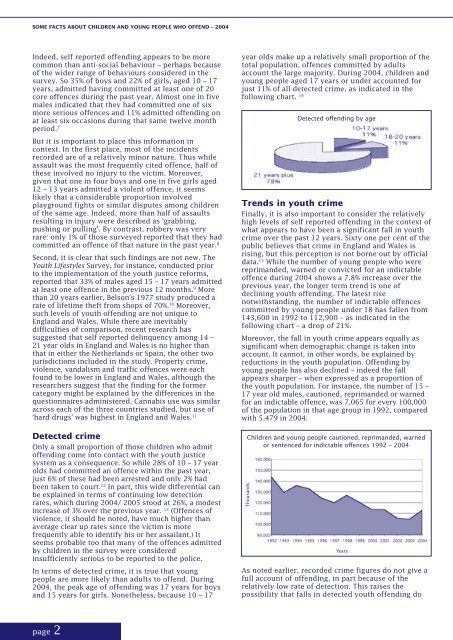Youth Crime briefing - Nacro
Youth Crime briefing - Nacro
Youth Crime briefing - Nacro
- No tags were found...
You also want an ePaper? Increase the reach of your titles
YUMPU automatically turns print PDFs into web optimized ePapers that Google loves.
Some facts about children and young people who offend – 2004Indeed, self reported offending appears to be morecommon than anti-social behaviour – perhaps becauseof the wider range of behaviours considered in thesurvey. So 35% of boys and 22% of girls, aged 10 – 17years, admitted having committed at least one of 20core offences during the past year. Almost one in fivemales indicated that they had committed one of sixmore serious offences and 11% admitted offending onat least six occasions during that same twelve monthperiod. 7But it is important to place this information incontext. In the first place, most of the incidentsrecorded are of a relatively minor nature. Thus whileassault was the most frequently cited offence, half ofthese involved no injury to the victim. Moreover,given that one in four boys and one in five girls aged12 – 13 years admitted a violent offence, it seemslikely that a considerable proportion involvedplayground fights or similar disputes among childrenof the same age. Indeed, more than half of assaultsresulting in injury were described as ‘grabbing,pushing or pulling’. By contrast, robbery was veryrare: only 1% of those surveyed reported that they hadcommitted an offence of that nature in the past year. 8Second, it is clear that such findings are not new. The<strong>Youth</strong> Lifestyles Survey, for instance, conducted priorto the implementation of the youth justice reforms,reported that 33% of males aged 15 – 17 years admittedat least one offence in the previous 12 months. 9 Morethan 20 years earlier, Belson’s 1977 study produced arate of lifetime theft from shops of 70%. 10 Moreover,such levels of youth offending are not unique toEngland and Wales. While there are inevitablydifficulties of comparison, recent research hassuggested that self reported delinquency among 14 –21 year olds in England and Wales is no higher thanthat in either the Netherlands or Spain, the other twojurisdictions included in the study. Property crime,violence, vandalism and traffic offences were eachfound to be lower in England and Wales, although theresearchers suggest that the finding for the formercategory might be explained by the differences in thequestionnaires administered. Cannabis use was similaracross each of the three countries studied, but use of‘hard drugs’ was highest in England and Wales. 11Detected crimeOnly a small proportion of those children who admitoffending come into contact with the youth justicesystem as a consequence. So while 28% of 10 – 17 yearolds had committed an offence within the past year,just 6% of these had been arrested and only 2% hadbeen taken to court. 12 In part, this wide differential canbe explained in terms of continuing low detectionrates, which during 2004/ 2005 stood at 26%, a modestincrease of 3% over the previous year. 13 (Offences ofviolence, it should be noted, have much higher thanaverage clear up rates since the victim is morefrequently able to identify his or her assailant.) Itseems probable too that many of the offences admittedby children in the survey were consideredinsufficiently serious to be reported to the police.In terms of detected crime, it is true that youngpeople are more likely than adults to offend. During2004, the peak age of offending was 17 years for boysand 15 years for girls. Nonetheless, because 10 – 17year olds make up a relatively small proportion of thetotal population, offences committed by adultsaccount the large majority. During 2004, children andyoung people aged 17 years or under accounted forjust 11% of all detected crime, as indicated in thefollowing chart. 14Trends in youth crimeFinally, it is also important to consider the relativelyhigh levels of self reported offending in the context ofwhat appears to have been a significant fall in youthcrime over the past 12 years. Sixty one per cent of thepublic believes that crime in England and Wales isrising, but this perception is not borne out by officialdata. 15 While the number of young people who werereprimanded, warned or convicted for an indictableoffence during 2004 shows a 7.8% increase over theprevious year, the longer term trend is one ofdeclining youth offending. The latest risenotwithstanding, the number of indictable offencescommitted by young people under 18 has fallen from143,600 in 1992 to 112,900 – as indicated in thefollowing chart – a drop of 21%.Moreover, the fall in youth crime appears equally assignificant when demographic change is taken intoaccount. It cannot, in other words, be explained byreductions in the youth population. Offending byyoung people has also declined – indeed the fallappears sharper – when expressed as a proportion ofthe youth population. For instance, the number of 15 –17 year old males, cautioned, reprimanded or warnedfor an indictable offence, was 7,065 for every 100,000of the population in that age group in 1992, comparedwith 5,479 in 2004.ThousandsDetected offending by ageChildren and young people cautioned, reprimanded, warnedor sentenced for indictable offences 1992 – 2004YearsAs noted earlier, recorded crime figures do not give afull account of offending, in part because of therelatively low rate of detection. This raises thepossibility that falls in detected youth offending dopage
















